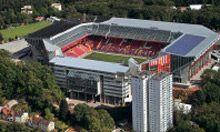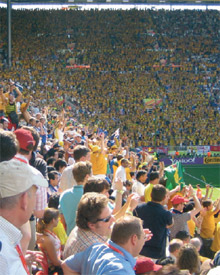
Welcome guests
During the 2006 World Cup Championship in Germany, Kaiserslautern was one of the 12 World Cup Cities to host the games. Fritz-Walter Stadium on the Betzenberg hilltop was the venue of four games in the preliminary rounds and one quarter-final. Kaiserslautern has 105,000 inhabitants, making it the smallest World Cup city in which a second stage (last 16) game has ever been played.
The football frenzy in Kaiserslautern was not only restricted to native Kaiserslautern football fans, but quickly infected the visiting football fans from around the world. The stadium, or the "Betze", as it is fondly called by the locals, was completely sold out for each of the World Cup games. Thousands of fans also crowded onto the Fan Mile and thronged the public-viewing locations in the city centre.
Secure and friendly presence
A total of almost quarter a million visitors were counted in the Kaiserslautern stadium. However, regardless of how enthusiastic people are about the games, it is important to realise that such large crowds also involve high security and safety risks, particularly when it is an international event with the entire world looking on. It's no wonder, then, that the police in Kaiserslautern were on highest alert. The police presence was highly visible everywhere in the city and in the stadium, without being intrusive.
A concept that worked. "There was no trouble during any of the World Cup games," summed up Chief Superintendent Uwe Giertzsch, who, as the head of Police Station I and the stadium section, is in charge of security at Fritz-Walter Stadium. "We had fewer problems during the World Cup games than we usually have during a regular German Football League game."
Cutting-edge video surveillance
As part of a start-of-the-art video surveillance system, 77 MOBOTIX cameras helped to ensure the security and safety of the football fans during the World Cup.
Keeping track
"I knew from the beginning that video surveillance would be important," said Chief Superintendent Uwe Giertzsch, who was also involved in developing the security concept for the 2006 World Cup in Kaiserslautern. "As police, we wanted to be visible, but to avoid anything that may make people feel uncomfortable, not to mention threatened. Nevertheless, it was vital that we maintain an overview of the situation at all times. To do so, we needed highly-detailed images of the situation on location in order to be able to recognise possible disturbances early and make the right decisions quickly."
Based on the requirements of the security staff, GPC GmbH, an independent engineering office, drew up the documents for the tendering procedure. They included a sophisticated video surveillance system that would be able to provide images of a wide area as well as to zoom in to capture full-format images of specific individuals.
"We specified MOBOTIX cameras to monitor the entrance and other inside areas," said Claus Schmitt, Senior Consultant at GPC, "because our experience with this technology to date has been excellent in terms of costs, performance and quality. With respect to organization and economy, it is definitely the most cost effective solution."
Cost effective thanks to highly detailed images
One of the reasons that this technology is so attractively priced is the fact that MOBOTIX uses just one camera where other manufacturers need two. Consequently, only one camera was installed to monitor two turnstiles side by side. Despite this, the detail in the images is sharper because the images are recorded as mega pixel images containing twelve or six times as many pixels as the CIF standard (352 x 288) or 2CIF resolution (704 x 288), the technology that is generally used in stadiums. As a result, these cameras are also able to record images of individuals that are clear enough to serve as evidence at a later date, if necessary, which was one of the stipulations made by the police.
Cost effective thanks to economical emergency power supply highly detailed images
There were also many other reasons why Kaiserslautern was, by implementing MOBOTIX, able to install the least expensive video surveillance system of all the World Cup stadiums.  They include the reduced costs of installing the necessary cables using standard IT network technology components, even wireless is no problem, as well as the uncomplicated power supply.
They include the reduced costs of installing the necessary cables using standard IT network technology components, even wireless is no problem, as well as the uncomplicated power supply.
MOBOTIX deliberately designed its cameras using no moving parts to guarantee that they are very robust and low maintenance. As a result, they require no heating in the winter - and consume very little power, i.e. under 3 watts, whereas other systems use between 7 and 10 and up to 25 watts in the winter. Providing an emergency power supply is easy and economical because a 240 V connection is not required.
Cost-effective thanks to fewer storage PCs
Thanks to the intelligence and processing power inside the camera, the number of storage PCs needed is low and using Linux as the operating system, there are no licence fees.
Complex requirements
"To provide better control for the monitoring of the entrance areas and the grandstands, it was also necessary to install swivelling and tilting analogue pan-tilt-zoom solutions," Claus Schmitt added. Dome cameras were specified for the outside areas and high-resolution cameras were specified for the outside areas and high-resolution cameras made by TVI-Lederer for inside the stadium. These cameras are able to perform a frame-filling zoom-in on individuals on the other side of the stadium.
In the end, Siemens was awarded the contract for all the electrical work, while WVE GmbH, the service provider who also installed the state-of-the-art video traffic monitoring system in Kaiserslautern before the start of the World Cup, was commissioned to configure and activate the MOBOTIX cameras.
Simple integration
A 4-fold framegrabber card was used to digitise the analogue camera images and integrate them into the MOBOTIX network. The control protocol of the Siemens dome cameras was also programmed into the MOBOTIX server software so that the control commands could be transmitted via the network. In addition, all the MOBOTIX camera images were stored with 2 fps (VGA) - 16 fps would also have been technically possible - and the dome images with 12 fps (VGA) on different servers for five hours.
Video management included
No additional video management system was required to manage the total 87 cameras because all the necessary applications were included with the standard functions of the MOBOTIX cameras and the free MOBOTIX MxControlCenter program.
Based on the very strict and specific requirements of the police, MOBOTIX added a number of different features to the program. The camera symbols, for example, can be positioned in a background layout, while the individual camera's current operating mode is indicated in colour. Convenient preview windows allow a quick look, colour-coded soft buttons simplify the allocation to the cameras and any user can compile their own surveillance area. Even the Siemens dome cameras are now being controlled individually with the MxControlCenter. Another advantage: the images received from the many cameras can be displayed live on one screen at the same time using a high frame rate.
Finally, the network technology made it possible to easily access all the camera images remotely via the Internet, for example, from the traffic control centre or police headquarters.
Compliments all round
Chief Superintendent Uwe Giertzsch is very satisfied with the surveillance technology. "Our colleagues in the control centre were extremely impressed with the camera support. They were able to identify any problems early and take appropriate action before the situation could get out of hand." The head of the stadium security team was particularly proud Woof the fact that colleagues who had worked in security in the other World Cup stadiums had nothing but praise for the new system. "They were really impressed by the technology."
















